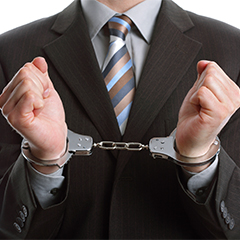The ACFE Puts a Spotlight on White Collar Crime
November 14, 2016 | Accounting Standards, Business Plans, Fraud Prevention
 According to the 2016 Report to the Nations on Occupational Fraud and Abuse published by the Association of Certified Fraud Examiners (ACFE), the average organization loses 5% of its annual revenues to fraud. Bear in mind, that’s the top line of your income statement, not the bottom. So, your company is expected to lose an average of $50,000 to thieves for every $1 million in annual revenue.
According to the 2016 Report to the Nations on Occupational Fraud and Abuse published by the Association of Certified Fraud Examiners (ACFE), the average organization loses 5% of its annual revenues to fraud. Bear in mind, that’s the top line of your income statement, not the bottom. So, your company is expected to lose an average of $50,000 to thieves for every $1 million in annual revenue.
Although small and large companies suffered the same median fraud losses ($150,000) in the latest fraud study, a small business often feels the effects of fraud losses more profoundly than a larger organization. Furthermore, according to the ACFE reports, white collar crime tends to be more common among smaller businesses. Small organizations (with fewer than 100 employees) were the most common victims in the 2016 study, at approximately 30%, while large organizations (with more than 10,000 employees) accounted for the fewest cases, at 20.5%.
Proactive Maine business owners can take steps to minimize their fraud risks. The ACFE has established a weeklong campaign during the third week of November to promote antifraud efforts. You can jump in by initiating a fraud awareness campaign at your workplace. Here are some simple ideas.
Visit the ACFE’s Website
The ACFE offers free resources that managers and owners can download quickly, and educating employees about fraud prevention and detection techniques doesn’t necessarily have to be costly or time consuming. Some of the resources include:
- Posters to display in your lunchroom,
- Handouts and videos that can serve as training materials for your staff, and
- Press releases that can double as content for social media posts, and
You can even sign up as an official supporter of International Fraud Awareness Week, which runs from November 13 – 19, 2016.
Review Your Internal Controls
Your company may already have policies and procedures in place to detect and prevent fraud. Together, these antifraud efforts are known as your internal control system. International Fraud Awareness Week is a good time to pause and reflect on your internal controls. Ask your management team: Based on today’s global, technology-driven marketplace, are our existing internal controls adequate? And how could we make them stronger?
The Committee of Sponsoring Organizations of the Treadway Commission (COSO) is a joint initiative of five private sector accounting and finance organizations. They list five components of effective internal control systems:
- Control environment. Relevant factors in the control environment include the integrity, ethical values, management operating style and delegation of authority. The ethical tone that management sets filters down the organizational chart.
- Risk assessment. Companies should continually evaluate internal weaknesses and external threats. Once they’ve been identified, weaknesses and threats need to be eliminated, or at least reduced and monitored.
- Information and communication. Strong controls allow employees to identify, capture and exchange information. Effective communication ensures information flows to the right people inside and outside the organization.
- Control activities. Strong systems include formal policies and procedures to ensure management’s directives are carried out. Examples of control activities include authorization of transactions, accounting reconciliations, supervisory reviews of operating performance, physical security of assets and segregation of duties.
- Monitoring. Management should frequently review and improve antifraud control performance, because risk factors change continually.
COSO recommends that companies design their antifraud controls “to provide reasonable assurance [of] the achievement of objectives in the effectiveness and efficiency of operations, reliability of financial reporting, and compliance with laws and regulations.” A strong internal controls program — including fraud prevention and detection training, proactive data monitoring and analysis, employee support groups, management review, and whistleblower hotlines — can be essential in preventing and detecting fraud.
Get Help from the Professionals
In the fight against white collar crime, your accountant and attorney are allies. In fact, many companies solicit outside help with fraud awareness training. A forensic specialist can present on warning signs and real-life horror stories during internal fraud training sessions. He or she also can help the management team perform a formal fraud risk assessment that identifies weaknesses in your internal controls and recommends possible fixes.
A forensic specialist can discreetly review your records and books in an agreed-upon-procedures engagement if you suspect fraudulent activities. If fraud is unearthed, they can expand the scope of the engagement into a full-blown fraud investigation.
When it comes to investigating fraud, outside fraud examiners are often more efficient than insiders. This is because they’re disinterested third parties with no emotional attachments or preconceived notions about the accused. In addition, they’re experienced in common fraud scams and know where to look for evidence. Forensic accountants and attorneys also know how to build a comprehensive case using analytical and interrogation techniques that will withstand legal scrutiny.
An Ongoing Battle
It’s important for businesses to remain focused on fraud awareness even after International Fraud Awareness Week is over, because these crimes happen year-round. Generally, perpetrators need three elements in place to act: motive, opportunity and rationalization. Regular staff training and strong internal controls eliminate the opportunity to commit fraud and deter would-be fraudsters by letting them know that you won’t tolerate fraud and have implemented controls to detect it.
